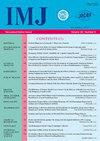吻合口瘘高危患者手术策略的选择
Q4 Medicine
引用次数: 0
摘要
肠切除术是针对紧急适应症进行的最常见的手术之一,最困难的是在原发性腹腔感染、肠壁多处缺损以及患者一般严重的情况下,做出有利于形成一级吻合的决定。为了改进肠吻合口手术患者术后并发症的诊断和预防方法,以及手术治疗策略的个性化,对96例患者的治疗结果进行了分析。血清冷冻球蛋白水平采用改良的A.E.Kalovidoris方法测定。根据D.Dindo等人(2004)的分类对手术治疗的结果进行了评估。手术前使用冷冻球蛋白水平会显著影响手术策略:在较低程度上,可以切除一段小肠并形成原发性小肠吻合;平均而言,可以通过卸载肠造口或腹膜外吻合位置(如果可能)进行小肠吻合,并用培养探针对吻合进行减压;在高情况下,用肠造口术或“延迟”吻合的变体来补充吻合的性能是有利的,在患者的严重一般情况下,形成最终的小肠造口是有利的。确定冷球蛋白血症水平作为肠吻合缝合失败预后的标志,并根据该指标的水平使用不同的手术策略,有助于显著改善接受小肠段切除的患者的手术治疗的直接结果。所提出的策略实际上消除了多阶段手术干预的实施,并有助于缩短患者的治疗时间,降低术后并发症和死亡率。关键词:冷球蛋白血症,外科治疗,小肠,吻合。本文章由计算机程序翻译,如有差异,请以英文原文为准。
CHOICE OF SURGERY TACTICS IN PATIENTS WITH HIGH RISK OF ANASTOMOTIC LEAK DEVELOPMENT
Intestinal resection is one of the most common surgeries performed on urgent indications, the most difficult is the decision in favor of the formation of primary anastomosis in the case of primary infection of abdominal cavity, multiple defects of the intestinal wall, as well as the general serious condition of a patient. In order to improve the methods of diagnosis and prevention of post−surgery complications, as well as personification of surgical tactics of treatment in the patients undergoing anastomotic surgeries in intestine, the results of treatment of 96 patients were analyzed. The level of serum cryoglobulins was determined by the method of A. E. Kalovidoris with modifications. The results of surgical treatment were evaluated according to the classification of D. Dindo et al. (2004). The use of cryoglobulin levels before surgery can significantly affect surgical tactics: at a low degree it is possible to perform resection of a segment of small intestine with the formation of primary small intestinal anastomoses; at average − it is possible to perform small−intestinal anastomoses with unloading intestinal stoma or with the location of the anastomosis extraperitoneally (if possible) and decompression of the anastomosis with an incubation probe; at high − it is expedient to supplement performance of an anastomosis with a variant of an enterostomy or "delayed" anastomoses, at a severe general condition of patients it is expedient to form final small intestinal stoma. Determining the level of cryoglobulinemia as a marker of the prognosis of failure of the sutures of intestinal anastomoses and the use of differentiated surgical tactics depending on the level of this index contributes to a significant improvement in direct results of surgical treatment of the patients undergoing resection of small intestine segments. The proposed tactics virtually eliminate the implementation of multi−stage surgical interventions and helps to reduce the duration of treatment of patients, reduce the level of post−surgery complications and mortality.
Key words: cryoglobulinemia, surgical treatment, small intestine, anastomoses.
求助全文
通过发布文献求助,成功后即可免费获取论文全文。
去求助
来源期刊

International Medical Journal
医学-医学:内科
自引率
0.00%
发文量
21
审稿时长
4-8 weeks
期刊介绍:
The International Medical Journal is intended to provide a multidisciplinary forum for the exchange of ideas and information among professionals concerned with medicine and related disciplines in the world. It is recognized that many other disciplines have an important contribution to make in furthering knowledge of the physical life and mental life and the Editors welcome relevant contributions from them.
The Editors and Publishers wish to encourage a dialogue among the experts from different countries whose diverse cultures afford interesting and challenging alternatives to existing theories and practices. Priority will therefore be given to articles which are oriented to an international perspective. The journal will publish reviews of high quality on contemporary issues, significant clinical studies, and conceptual contributions, as well as serve in the rapid dissemination of important and relevant research findings.
The International Medical Journal (IMJ) was first established in 1994.
 求助内容:
求助内容: 应助结果提醒方式:
应助结果提醒方式:


